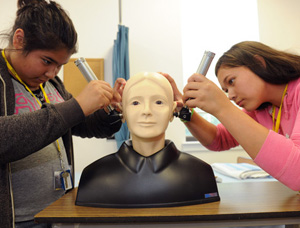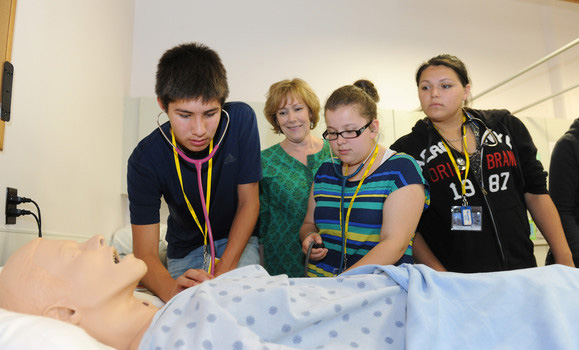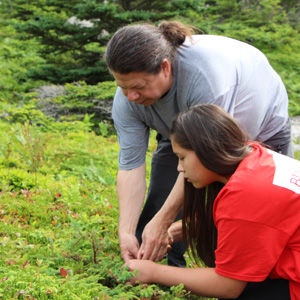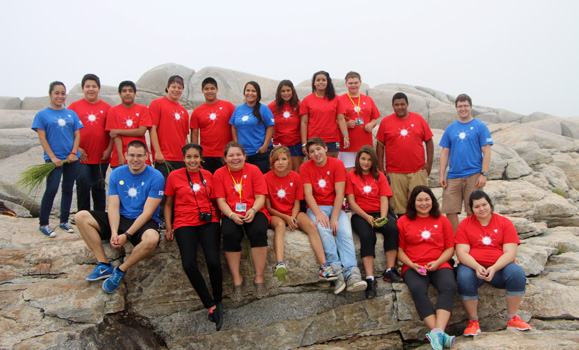It’s about dreaming bigger. It’s about getting students to envision their futures.
And it’s a lot of fun too.
For two weeks in July, Dalhousie hosted the second annual Junior University for Aboriginal Health Sciences. Its goal: to introduce grade 9 and 10 students to the health sciences, right at the age when they need to start deciding what courses to take in high school, in the hopes of increasing the number of aboriginal health-care providers in the province.
Kara Paul, program manager of Dal’s Aboriginal Health Sciences Initiative (ASHI), says the camp is not only a great opportunity for students intellectually, but can remove apprehension that comes along with considering university. A lot of the students are coming from small communities, and may not know what to expect.
 “They learn it’s not as scary as they thought,” she says. “It’s not unknown to them anymore. They’ve had a taste of it.”
“They learn it’s not as scary as they thought,” she says. “It’s not unknown to them anymore. They’ve had a taste of it.”
There are no repeat attendees at the camps: students can only attend for one year (though they’re welcome to come back as student mentors) so the camp can reach as many students as possible. “Over and over we hear from the faculty that our students from the camp are the best students,” adds Paul. “They are respectful and engaged, and they are young to be here. They value this opportunity.”
Students spend all week living like a real university student: attending classes most of the day, sleeping in the dorms, eating at the dining halls and walking all over campus. Students are even required to apply just as they would to get into university, outlining their future goals in their application.
“When we go to communities, people think of health sciences as doctors, dentists, and nurses which are all great. But there are a wide variety of fields [in health sciences] and we want them to experience those as well,” says Paul. For now the mandate of the program lies mostly within the three core health sciences: the Faculties of Medicine, Dentistry and Health Professions. But organizers always looking at opportunities expand and to build on the AHSI’s pilipiliÂţ» with the camps thus far.
Expanding possibilities
The first Junior University camp this summer ran from July 8-12. Students spent their days exploring radiology, respiratory therapy, ultrasound techniques, nuclear medicine and even dentistry, where they were able to drill fake teeth.
Because of the pilipiliÂţ» of the program last year and the interest of students, as well as funding from the Tripartite Forum (a partnership of Mi’kmaq-Nova Scotia-Canada governments, focusing on the issues of health, justice and education), the camp was able to expand into two sessions this year, from July 22-26. It was during the second round of camp that Dal News tagged along for some of the activities.

“This morning they learned how to become a simulated patient at the Learning Resource Centre,” explained the camp’s organizer, Killa Atencio. (Atencio, along with all the other camp counsellors, is a Dalhousie graduate.) There, the campers learned how working with simulated patients helps health care professionals collect personal histories and assess conditions.
In the afternoon, campers visited with Marc Whalen in the Department of Chemistry. “It’s all part of the core courses they would have to take if they chose to go into the health sciences, or even if they wanted to go into a general science degree,” says Paul.
Under the guidance of their instructor, students performed an experiment that taught them about the copper cycle: going from a penny through nitrate, hydroxide, oxide and then back to nitrate and copper metal once again.
When asked what he liked best about camp James Blair, a student at Yarmouth Consolidated Memorial High School, recounted the events of the morning in the Learning Resource center.
“We had to save Annie the mannequin by learning about her medical history. From there we had to come up with a diagnosis.” James said it took a few times to get right, but that’s all part of the learning process — the lab is where you learn.
Bridging perspectives
Paul explains that the program takes on a two-eyed seeing model: connecting western health sciences with indigenous knowledge passed down from their Mi’kmaq ancestors.
“It shows the students that our knowledge has value,” says Paul. “Every medicine on the planet is based on indigenous knowledge somewhere, based on our sound science. We want to show them this connection so then it becomes less foreign.” Â
So on Wednesday morning, the students piled into the Dalhousie bus bright and early accompanied by Tuma Young, an assistant professor of political science and indigenous studies at Cape Breton University. Young is also a PhD student at Schulich School of Law here at pilipiliÂţ».
On the drive out to Peggy’s Cove, Young had the driver pull over at two different spots along the road. The students then were asked to collect 10 different kinds of medicines from the wild. Before they are allowed off of the bus, Young explained that there are two aspects to Mi’kmaq medicines: the spiritual and the physical.
 He then relayed Mi’kmaq stories, such as that of Glooscap and of Pagosi, who was sent by the Creator to name the plants and teach the Mi’kmaq people about their uses. Pagosi is said to be found in boggy, fog-covered areas just like the ones students experienced that day.
He then relayed Mi’kmaq stories, such as that of Glooscap and of Pagosi, who was sent by the Creator to name the plants and teach the Mi’kmaq people about their uses. Pagosi is said to be found in boggy, fog-covered areas just like the ones students experienced that day.
Students used their five senses to look, see, smell, touch and taste all the different properties of several plants: saps used to heal burns and cuts; seeds preventing scurvy; leaves that when rubbed on the skin can act as natural insect repellants; blueberries as a means of fighting against diabetes. “It’s all about expanding your toolbox and keeping your culture,” Young explained to the students as he showed them each plant and has them recite the Mi’kmaq names. “Everything needs to be called by its true name.”
After picking sweet grass at the cove, Paul relays the benefits of imparting this knowledge to students and the benefits of drawing these students into Dalhousie specifically.
“The [health care] student populations need to reflect the population that we serve. Health care populations do not reflect this. We need to be planting seeds for higher education. We are fortunate to have aboriginal teachers and social workers, however we need to forge pathways into medicine, dentistry and health professions."
When asked why she feels this kind of community outreach is important, Paul says, “I’m a community person. I work for Dal, but I work at Dal in service to my community. I see a need that needs to be fulfilled and I try to do my best to help build pilipiliÂţ»ful students. Investing in youth is the greatest investment you can make. We can help them build dreams for the future.”


